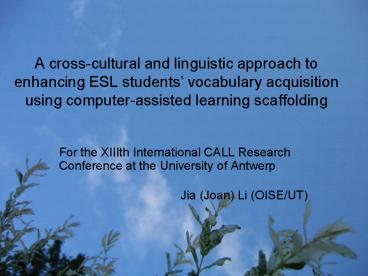A cross-cultural and linguistic approach to enhancing ESL students - PowerPoint PPT Presentation
1 / 24
Title:
A cross-cultural and linguistic approach to enhancing ESL students
Description:
Jia (Joan) Li (OISE/UT) Outline Background and context Methodology Major research findings Significance Background and Context Serious English Academic ... – PowerPoint PPT presentation
Number of Views:1166
Avg rating:3.0/5.0
Title: A cross-cultural and linguistic approach to enhancing ESL students
1
A cross-cultural and linguistic approach to
enhancing ESL students vocabulary acquisition
using computer-assisted learning scaffolding
- For the XIIIth International CALL Research
Conference at the University of Antwerp - Jia (Joan) Li (OISE/UT)
2
Outline
- Background and context
- Methodology
- Major research findings
- Significance
3
Background and Context
- Serious English Academic English literacy
- Ontario Secondary Literacy Tests
4
Methodological overlap and mismatch
5
24 Chinese ESL students in Grades 9-10 and 5 ESL
teachers
6
A sample of popular comic books
7
Chinese story books
8
Bilingual instructions
- Chinese vocabulary equivalents
- Grammatical explanations in Chinese
9
Samples of bilingual electronic handheld
dictionaries in the ESLB class
10
A mixed methodology design
- Three phases
- Initial semi-structured interviews/conceptual
analysis - Reading experiments/repeated measures ANOVAs
- Oxfords strategy inventory of language learning
(SILL) and follow-up interviews/Descriptive
statistics and thematic analysis
11
Reading Experiments
12
Vocabulary Levels Tests
- Monolingual Vocabulary Levels Tests
- bridge
- crossing _____ image
- double _____ without delay
- immediately _____ twice as much
- piece
- reflection
- Bilingual Vocabulary Levels Tests
- bridge
- crossing _____ ??,??
- double _____ ??
- immediately _____ ???
- piece
- reflection
13
WordNet monolingual dictionary
14
Monolingual/bilingual dictionary
15
Unknown words database
16
Blank words feature in the practice mode
17
Parts of speech feature in the grammar mode
18
Findings
- An apparent preference for vocabulary
instructional strategies - Mismatches identified between Chinese and North
American vocabulary teaching approaches that
students experienced - Compensatory strategies
19
Bilingual-resourced strategies students preferred
Strategies Students Preferred Bilingual-Based
Students Strategies Reading bilingual books 5
Students Strategies Using electronic bilingual dictionaries 80
Students Strategies Using online bilingual dictionaries 25
Students Strategies Using online translation programs 20
Students Strategies Translating passages and taking notes 10
Students Strategies Memorizing vocabulary using English-Chinese word lists 10
Students Strategies Asking classmates for meanings (bilingual peer coaching) 25
Students Strategies Speaking English with competent bilingual friends 5
Students Strategies Watching TV in English with Chinese subtitles 15
Teachers Strategies Providing Chinese definitions of words 10
Teachers Strategies Encouraging students to understand word meanings in Chinese 10
Strategies in Need Providing detailed and explicit explanations (T) 30
Strategies in Need Asking classmates for meanings (bilingual peer coaching) (S) 10
20
Findings continued
- Repeated-measures ANOVAs
- technology-supported scaffoldings
- Significant variations
- existing levels of English proficiency
- differences in understanding word meanings
between L1 and L2
21
Time versus Version
22
Significance
- A resource-orientated functional approach versus
dichotomy of language teaching and learning
approach - Bilingual vocabulary levels tests
- Feasible recommendations
- explicitly promoting the use of L1
- employing a diversity of Chinese approach-based
memorization strategies
23
A cross-cultural and linguistic approach to
ELLs literacy development in a multilingual
Canada
- Bridging ELLs literacy gap
- Mainstream instructional practices
- - students cultural, educational and
linguistic capital their legacy of learning
experiences, L1 competence - - students increasing orientation towards
technology
24
Thank youEmail jiali_at_oise.utoronto.ca































